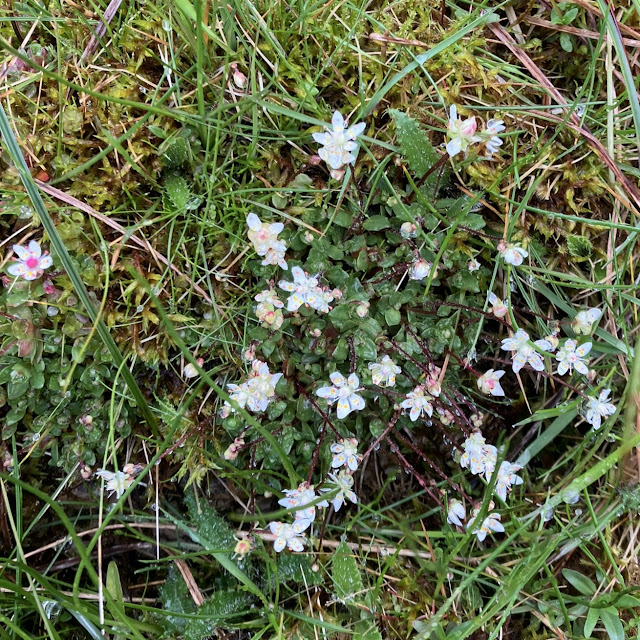I've been climbing mountains, mostly in the UK, for much of my life - although moving to Dorset on the south coast of England means that I get out far less often than I would like. The last couple of months have seen trips to the Lake District and the Scottish Highlands respectively. (The photo above is of magnificent An Teallach, near Ullapool in north west Scotland. I'll get to that shortly.)
I'm always on the look-out for interesting wildlife on these walks, although the photographic record is limited to the scope of my iPhone: the SLR and long lens do not accompany me on these expeditions, as its hard enough work already without the extra weight. Mountain plants are of particular interest: if nothing else, they give me an excuse to stop and draw breath.
Anyway, the first trip was a family holiday the Lake District in May 2024. A showery day saw us climb a couple of fells near Haweswater, including Harter Fell (below).
 |
| View from Harter Fell down to Small Water |
The Lake District fells rarely seem as flower-rich as other corners of the British uplands, and the Lakeland fells certainly do not rate as highly as plant rarity 'hotspots' like Teesdale in the Pennines or Ben Lawers in the Southern Highlands. But I was pleasantly surprised by the range of species that we encountered on and around Harter Fell. The track up to Small Water passed a good number of Common Butterworts Pinguicula vulgaris (below).
 |
| Common Butterworts - Small Water, Cumbria |
 |
| Common Butterwort (detail) |
While, as their name suggests, there's nothing rare about Common Butterworts, I remain fascinated by carnivorous - in this case, insectivorous - plants. Butterworts have the ability to make their own food: their green colour shows that they photosynthesise. But the pallid yellow-green star of leaves holds a nasty secret: they secrete a stricky mucous-like fluid that captures insects that are slowly digested as the leaves curl around over them. This is a necessary nutritional supplement given the plants' habitat: nutrient poor, often acidic, bogs.
 |
| Round-leaved Sundew |
At Small Water, where I had the pleasure of swimming a year before, we left the path and headed south -east following a direct line up the grassy flank of Harter Fell. I wouldn't recommend this as an ascent route, as it gets steep and slippery higher up, but it did take us past some plant-rich wet flushes. The most noticeable flower was one of my favourites: Starry Saxifrage Micranthes stellaris (below).
 |
| Starry Saxifrage - Harter Fell, Cumbria |
This species (along with Alpine Saxifrage) has now been split from most other saxifrages (Stace, 2019) - it is in genus Micranthes rather than Saxifraga - although this is due to molecular, rather than visual differences. Either way, it's a lovely flower; note the two obvious yellow spots at the base of each white petal. Starry Saxifrage is a widespread species of the uplands (see its NBN distribution map here), and particularly favours wet locations. Well, it's in the Lake District after all.
 |
| Pyrenean Scurvygrass - Harter Fell, Cumbria |
The other notable flowers here were Mossy Saxifrage Saxifraga hypnoides. However, we saw much larger carpets of this on a walk along nearby Longsleddale a couple of days later (below) - a beautiful sight.
 |
| Mossy Saxifrage - Longsleddale, Cumbia |
Mossy Saxifrage forms mats of often densely-packed white flowers; its linear-shaped leaves certainly make you think of a moss. It is probably the most common of Britain's upland saxifrage species.
 |
| Cranberry - Great Howe, Longsleddale, Cumbria |
 |
| View from the summit ridge of Beinn a'Chlaidheimh |
We camped in the nearby glen (Strath na Sealga) and approached the mountain from the east. This approach, like many in Fisherfield, is trackless, and we were soon yomping across the usual mix of rock and bog. In one boggy corner, my eyes were drawn to an unusual sundew - Oblong-leaved Sundew Drosera intermedia (below).
 |
| Oblong-leaved Sundew - Beinn a'Chlaidheimh |
 |
| Dwarf Cornel - Beinn a'Chlaidheimh |


No comments:
Post a Comment